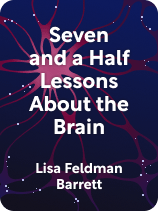

This article is an excerpt from the Shortform book guide to "Seven and a Half Lessons About the Brain" by Lisa Feldman Barrett. Shortform has the world's best summaries and analyses of books you should be reading.
Like this article? Sign up for a free trial here.
What does the organization of the brain look like? Is our brain just a layered structure?
Seven and a Half Lessons About the Brain by Lisa Feldman Barrett claims that the brain is organized as a network of neurons. By understanding the brain’s organization, we can recognize the flexibility and resilience of the human brain and learn what makes it different from the brains of other animals.
Keep reading to learn more about the organization of the brain.
Organization of the Brain
In her book, Barrett begins with an explanation of the organization of the brain: as a layered structure with specific parts and jobs, as has long been thought, but as a network of neurons (brain cells that receive and transmit information) that can all perform different tasks according to need. By understanding the brain’s organization, we can recognize the flexibility and resilience of the human brain and learn what makes it different from the brains of other animals.
We Can’t Know How the Brain Works Based on Appearance Alone
Barrett argues that the way we traditionally think of the human brain is based on outdated research. There’s a popular belief that the human brain has three distinct parts, each with distinct functions: a brain core (or “lizard brain”), a limbic system, and a neocortex. The three-layer model of the brain has long been used as “proof” that the human brain is more evolved than other animal brains.
This model became popular in the mid-20th century when doctor Paul MacLean identified structural similarities and differences among the brains of different animals:
- Humans, mammals, and lizards have similar-looking brain cores. He called this the lizard brain because it was thought to be a remnant of prehistoric animals, and he argued it was the seat of instinctual behavior—something all animals seem to share.
- Humans and mammals share the next layer of the brain, one that lizards don’t have. MacLean called it the limbic system and argued it was the seat of emotions, believing that only mammals (including humans) were capable of having emotions.
- Only humans have a neocortex, the outer layer of the brain, which he argued is the seat of rational thinking. This last layer is supposed to be unique to humans and hence the seat of our uniquely human capacities.
Barrett says that researchers debunked this model in the late 20th century, yet the general public still believes it to be true.
The problem is that this model relies on what brains look like to deduce what they can do. To combat this error, Barrett explains three truths about our brain’s structure and how it functions.
First, several parts of the brain are needed, for example, to breathe, to feel angry, or to make a plan. It’s not accurate to say that there’s one specific part of the brain that deals with a specific function.
Second, appearance and location aren’t the only determining factors of a neuron’s function. When researchers studied neurons (nerve cells) more closely, they found that neurons from animals and humans can look very different or be found in different parts of each brain, yet have similar genetic structures. Thus, different animals can have brain cores that look similar, for instance, but that doesn’t mean that they’re responsible for primitive, instinctual functions that we believe all animals share. Likewise, just because the outer layer of our brains (the neocortex) looks different from other animals’, it doesn’t mean that the animals lack the function that our neocortex plays.
Third, most brains, including the human brain, a monkey’s brain, and a lizard’s brain, develop in the same order. According to Barrett, the difference is that they develop different parts for different lengths of time. For example, all mammals and reptiles have a cerebral cortex (part of the neocortex), but the human cerebral cortex spends more time developing so it becomes larger and more complex than that of a monkey or lizard.
(Shortform note: Even different species of our ancestors developed at different paces. For example, the brains of Australopithecus afarensis, a hominid that lived between 3.85 and 2.95 million years ago, were 20% larger than the brains of chimpanzees and took much longer to develop. Much like modern-day humans, their brains continued to develop during childhood, making them dependent on adults of the species for a longer time.)
Thus, Barrett argues that human brains aren’t more evolved than others, as the myth of the three-layer brain would have us believe. Our brains just evolved differently from other animals, in a specific trajectory that made us who we are today—good at reading books, but bad at sleeping with our eyes open to stay aware of our surroundings, like guinea pigs.
The Brain Is a Network
Rather than a simple and static three-layer structure, Barrett says the brain is a complex and active web of neurons. Put simply, neurons are the messengers of the brain. They take in information and transmit electrical impulses to each other to communicate what is happening and how the body should react. For example, if you touch a hot stove, the neurons in your brain would receive that data and instantly tell your body to pull your hand back. Barrett goes on to explain that neurons form clusters and share information with each other. We can imagine these clusters as a group of people talking. Some of the neurons in those clusters communicate with other clusters in the vicinity (like neighbors chatting in the front yard).
Some clusters are bigger and more powerful than others (such as people who have a public forum or social influence). And some clusters communicate with other clusters across the brain, not just the ones nearby (as in email, a phone call, or on social media). In this way, the entire brain shares information and participates in shaping your experiences and behaviors.

———End of Preview———
Like what you just read? Read the rest of the world's best book summary and analysis of Lisa Feldman Barrett's "Seven and a Half Lessons About the Brain" at Shortform.
Here's what you'll find in our full Seven and a Half Lessons About the Brain summary:
- How the human brain develops and operates
- Why the brain isn't organized in the way you thought it was
- How brains collaborate with one another






